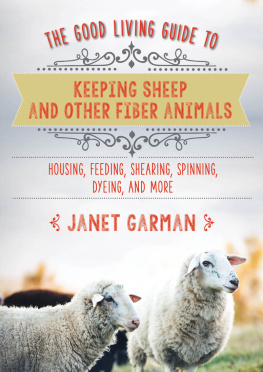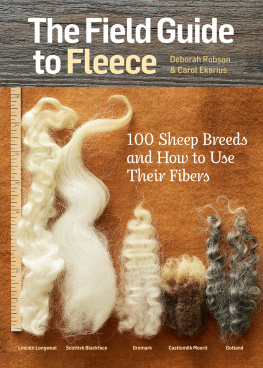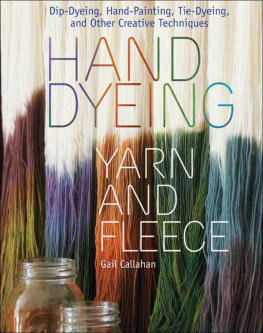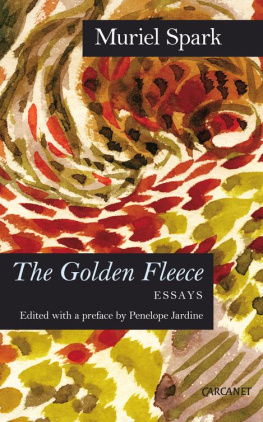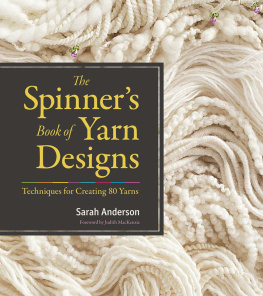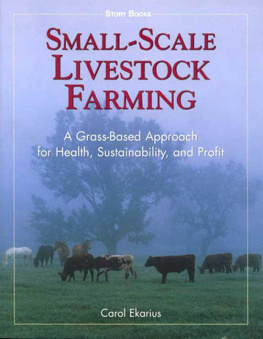The Fleece & Fiber Sourcebook

the Fleece & Fiber SOURCEBOOK
More than 200 Fibers from Animal to Spun Yarn
Deborah Robson & Carol Ekarius

The mission of Storey Publishing is to serve our customers by publishing practical information that encourages personal independence in harmony with the environment.
Edited by Gwen Steege, Deborah Burns, Sarah Guare, and Nancy D. Wood Art direction and book design by Mary Winkelman Velgos Text production by Jennifer Jepson Smith
Front cover photography by John Polak except Alpaca 2009 David C. Phillips/Garden Photo World and Dalesbred Sheep FLPA/Wayne Hutchinson/agefotostock.com
Back cover photography by Wayne Hutchinson/Minden Pictures
Author photgraphs on flap by Kristi Schueler (Deborah Robson) and Ken Woodard Photography (Carol Ekarius)
Interior photography by John Polak except as noted on 429
Photo research and coordination by Mars Vilaubi
Maps by Alison Kolesar
Illustrations on by Elayne Sears
Indexed by Kathryn Bright
Knit swatches by Diana Foster
Woven swatches by Jennifer Jepson Smith
2011 by Carol Ekarius and Deborah Robson
All rights reserved. No part of this book may be reproduced without written permission from the publisher, except by a reviewer who may quote brief passages or reproduce illustrations in a review with appropriate credits; nor may any part of this book be reproduced, stored in a retrieval system, or transmitted in any form or by any means electronic, mechanical, photocopying, recording, or other without written permission from the publisher.
The information in this book is true and complete to the best of our knowledge. All recommendations are made without guarantee on the part of the author or Storey Publishing. The author and publisher disclaim any liability in connection with the use of this information.
Storey books are available for special premium and promotional uses and for customized editions. For further information, please call 1-800-793-9396.
Storey Publishing
210 MASS MoCA Way
North Adams, MA 01247
www.storey.com
Printed in China by Toppan Leefung Printing Ltd.
10 9 8 7 6 5 4 3 2 1
LIBRARY OF CONGRESS CATALOGING-IN-PUBLICATION DATA
Robson, Deborah.
The fleece and fiber sourcebook / by Deborah Robson and Carol Ekarius.
p. cm.
Includes bibliographical references and index.
ISBN 978-1-60342-711-1 (hardcover : alk. paper)
1. Animal fibers. 2. Wool. I. Ekarius, Carol. II. Title.
TS1545.R66 2011
677'.3dc22
2010051175
Contents
PART 1
Sheep: Oodles and Boodles of Wool
Brecknock Hill and American Miniature Cheviot
Merino: Booroola, Est Laine, Fonthill, Peppin, Poll, South Australian, Tasmanian, Type A, and Type B Merino

PART 2
Other Species: The Rest of the Menagerie

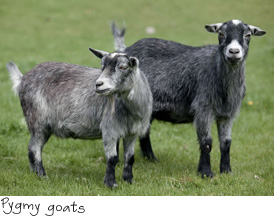
Preface
SOMETIME IN ANTIQUITY (no one is sure exactly when, but well tell you what is known on the subject in chapter one) a human discovered that fibers could be twisted and pulled to create a cord. This twisting and pulling of fibers probably occurred quite by happenstance, yet what a profound impact it came to have on humanity. The finest cords, when twisted or braided together, became larger cords thread, string, yarn, rope. Just think what handy inventions these must have been for cave dwellers, nomads, and other early people. And the
Before and after buddies. A Clun Forest ewe and fingerless mittens from Solitude Wools Clun Forest/alpaca yarn.

strands of twisted fiber could be woven together to become cloth. Suddenly clothing options expanded from the skin of a dead animal (one imagines, a heavy, smelly covering) to much lighter and more versatile garments.
Over the eons, since our foremothers and-fathers made their discovery, the fibers of animals and plants have served humankind and seemingly insinuated themselves in our DNA, carving out a place in the hearts and minds of fiber buffs everywhere. We are those kind of people. Like so many others who share this passion, we caught the bug as kids, starting to sew before we hit school, and learning the basics of knitting and crocheting by 10 or so. We both dabbled with some kind of loom as kids, and again a bit more seriously in our late teens, but it was in young adulthood when we each became serious about weaving, and soon after that we discovered spinning. Carols interest in fiber and food led to farming and raising critters, including sheep, and to writing about farming and animals. Debs home situation kept her from ever owning her own fiber animals, but her fiber addiction led her to pursue fiber professionally, as a writer, editor, and publisher of fiber-related magazines and books.
The two of us met years ago, in a context totally unrelated to fiber or animals, but as we discovered our common interest we became friends, and ultimately that led us to pursue the idea of doing a project together. This is our project, and our goal for it is to look at the animal fibers in a way that hasnt really been done before. We are looking in more depth than we believe anyone has before at the animals that have provided handspinners, knitters, and weavers with the foundation of their craft and artistry for thousands of years. You wont find patterns in this book, but we hope you will learn a great deal about the wool and hair fibers that have clothed and served us for generation upon generation, back to the person who first picked a fluff of wild sheep fibers out of a bush and twisted them together.
If you have ever run your hand over a fleece and sighed, picked up a ball of yarn and groaned with pleasure, run your hand along the light and breezy swath of a fine jersey woolen fabric and felt a tingle run down your spine, or worn a favorite wool jacket season after season, then you are a person who may just lose yourself in the pages that follow. We hope it tantalizes your senses and that it encourages you to venture into projects using fibers you never really thought of before.


Fiber Fascination
Make stuff. Stay home. Draw. Dress locally. Hand wash. Learn to darn.
Sarah Swett, Fiber Artist
Pick up a ball of yarn and cast stitches onto a needle. Start knitting. Quickly see a form begin to take shape a sweater for a loved one, perhaps, or fun socks to keep your tootsies warm on a cold winter night. Or pull a stool up to a beautiful loom and begin the rhythmic work of weaving weft into warp. Back and forth, back and forth, throw the shuttle, pull the beater: An intricate pattern begins to reveal itself. What great satisfaction this work brings. It connects us to our past and creates memories for our future. And it all starts with fiber.
Next page

